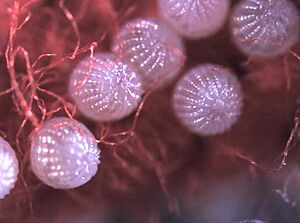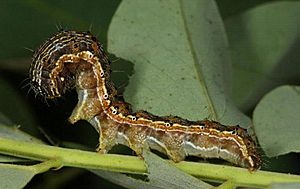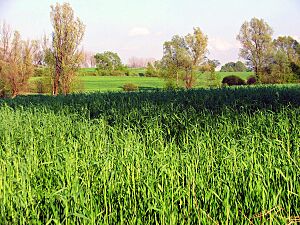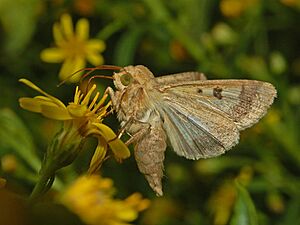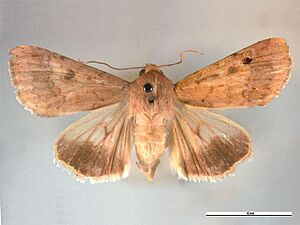Cotton bollworm facts for kids
Quick facts for kids Cotton bollworm |
|
|---|---|
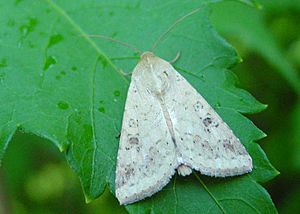 |
|
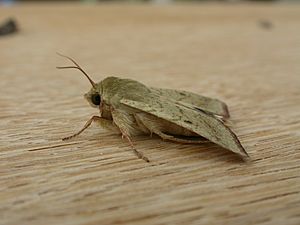 |
|
| Scientific classification | |
| Genus: |
Helicoverpa
|
| Species: |
armigera
|
| Synonyms | |
|
|
The cotton bollworm (scientific name: Helicoverpa armigera) is a type of moth. It belongs to the Lepidoptera group, which includes butterflies and moths. This moth is also called the corn earworm or Old World bollworm. In the UK, it's known as the scarce bordered straw because it travels there from other places.
The young cotton bollworms, called larvae or caterpillars, eat many different plants. They are a big problem for farmers because they damage important crops like cotton. This moth is known as a major pest around the world. It's important not to confuse it with a similar moth, Helicoverpa zea.
Contents
Where Do Cotton Bollworms Live?
This moth has two main types, or subspecies. One type, Helicoverpa armigera armigera, lives in central and southern Europe, Asia, and Africa. The other type, Helicoverpa armigera conferta, is found in Australia and Oceania.
Recently, the armigera subspecies has also spread to Brazil. From there, it has moved across much of South America and reached the Caribbean. These moths can travel long distances, even reaching northern places like Scandinavia.
What Do Cotton Bollworms Look Like?
Cotton bollworms can look very different in size and color. Their bodies are usually about 12 to 20 millimeters (about 0.5 to 0.8 inches) long. Their wings can spread out to 30 to 40 millimeters (about 1.2 to 1.6 inches) wide.
Female moths often have yellowish to orange front wings. Males have greenish-gray front wings. Both have a slightly darker band across the outer part of their wings. Their back wings are pale yellow with a thin brown edge and a dark spot in the middle.
Life Cycle of the Cotton Bollworm
A female cotton bollworm moth can lay hundreds of tiny eggs. She spreads these eggs on different parts of plants. If the weather is good, the eggs can hatch into larvae in just three days. The entire life cycle, from egg to adult moth, can be completed in a little over a month.
Eggs
The eggs are round and very small, about 0.4 to 0.6 millimeters (less than 0.03 inches) wide. They have a bumpy surface. When first laid, they are white, but they later turn greenish.
Larvae (Caterpillars)
The larvae, or caterpillars, grow for about 13 to 22 days. They can reach up to 40 millimeters (about 1.6 inches) long. Their color can vary, but they are usually greenish, yellow, or reddish-brown. Their head is yellow with some spots. They have three dark stripes along their back and a yellow stripe along their sides.
These caterpillars can be quite aggressive. Sometimes, they even eat other caterpillars. If they are bothered, they will drop from the plant and curl up on the ground.
Pupae
After the larvae are fully grown, they turn into pupae. This stage happens inside a silken cocoon in the soil, usually about 4 to 10 centimeters (1.6 to 4 inches) deep. They can also pupate inside cotton bolls or corn ears. The pupa stage lasts about 10 to 15 days.
What Plants Do They Eat?
The cotton bollworm is a "polyphagous" species, meaning it eats many different kinds of plants. Some of the most important crops they damage include:
- Tomatoes
- Cotton
- Pigeon peas
- Chickpeas
- Rice
- Sorghum
- Cowpeas
They also eat other plants like peanuts, okra, peas, soybeans, tobacco, potatoes, and corn. In some areas, they are found on over 120 plant species, especially those in the Solanum (like nightshade), Datura, Hyoscyamus, Atriplex, and Amaranthus families.
Why Are They a Problem for Farmers?
Cotton bollworms cause a lot of damage to crops, especially cotton, tomatoes, corn, chickpeas, and tobacco. When they attack cotton plants, the flowers might open too early and not produce any cotton. If the cotton bolls (the part that holds the cotton fibers) are damaged, they might fall off or produce poor quality cotton.
Sometimes, fungi and bacteria can also infect the damaged fruits, causing them to rot. If the caterpillars eat the growing tips of plants, it can stop the plant from developing properly, delay its growth, and make it drop its fruits.
How Do Farmers Manage Them?
Farmers use different ways to control cotton bollworms and protect their crops.
Prevention
- Trap crops: Planting certain plants like cowpea, sunflower, or marigold nearby can attract the moths away from the main crop.
- Intercropping: Planting different crops together, like corn with other plants, can help.
- Crop rotation: Changing the type of crop grown in a field each season can stop the moth population from building up.
- Field cleanup: Removing weeds, old crop parts, and leftover plants can reduce places for the moths to live and lay eggs.
- Bird perches: Setting up poles for birds to land on can encourage birds to eat the caterpillars.
Monitoring
It's important to watch for signs of the caterpillars. They eat buds, flowers, grains, and fruits. On cotton, they are found on the plant's leaves and reproductive parts. On corn and millet, they attack the grain. On tomatoes and beans, they bore into young fruits. On chickpeas, they eat the leaves and developing seeds.
Direct Control
- Handpicking: In small gardens, people can pick off and destroy eggs and young caterpillars by hand.
- Traps: Farmers use light traps and special "pheromone" traps (which use scents to attract moths) to catch adult moths.
- Natural enemies: Releasing helpful insects, like tiny wasps called Trichogramma (for example, T. brassilences or T. pretiosum), can help control the bollworm population because these wasps lay their eggs inside the bollworm eggs.
- Insecticides: Sometimes, special sprays are used to kill the caterpillars.
- Genetically modified crops: Some cotton plants, called Bt cotton, are changed to produce a natural substance that is harmful to the bollworms but safe for other animals.
Images for kids
See also
 In Spanish: Helicoverpa armigera para niños
In Spanish: Helicoverpa armigera para niños


